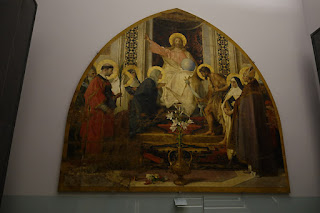Dear Art Lover,
Over the Christmas holiday, one of my
girlfriends and I were reminiscing about our favorite models from our days
together in Florence, Italy. This one young
man was intense and often studying during his breaks. He was a professional cyclist and his figure
told a lot. Another friend of mine had a
huge crush on him, so I organized a lunch one day at my nearby home and invited
him over while she cooked. Good
times. It is interesting to see how
models lives change. Some keep up with
the work for artists; many move on. Some
do a little of both.
 I had an idea many years ago that my New
Year’s Eve post would contain a new intentionally erotic artwork that I had
made. I wanted to bring back the memory
of Pompeii and counteract this strange custom in the US (at least) of thinking
negative thoughts about the bodies we have been given, as well as the bodies we
have developed from what we have been given.
We have the capacity to bring and receive joy. I believe that when we suppress many natural,
but positive, qualities in ourselves, those desires manifest in crude
ways. I think it is better to teach our
children healthy outlooks about our bodies and show them how magnificent the
overall design!
I had an idea many years ago that my New
Year’s Eve post would contain a new intentionally erotic artwork that I had
made. I wanted to bring back the memory
of Pompeii and counteract this strange custom in the US (at least) of thinking
negative thoughts about the bodies we have been given, as well as the bodies we
have developed from what we have been given.
We have the capacity to bring and receive joy. I believe that when we suppress many natural,
but positive, qualities in ourselves, those desires manifest in crude
ways. I think it is better to teach our
children healthy outlooks about our bodies and show them how magnificent the
overall design!
In this spirit, I would like to share with
you my charcoal drawing of a standing Francesco. I have not had time to create an intentionally erotic artwork, nor finish current figures in progress. However, Francesco is a beautiful man, so I hope you can forgive me for sharing this drawing of him today. I have many sketches of this model I wrote
about in the above paragraph, but this one was a long-term study. I am not sure why the school prefers to put
the male models in this rather somber pose, but so be it. Also, artists in the room got to pick their
easel location based on a point system.
Since I was never great about doing homework or concerned about points,
I was almost always last to choose. I
told myself that if I could get a good drawing from a position that no one else
wanted, I would learn more. But still,
this pose rather fits our somber and often serious thinker, Francesco.
Francesco
27
x 12" charcoal drawing on paper 2008
by
Kelly Borsheim
For
more information on this artwork, please visit:
As I was writing this post this morning, a
friend shared on Facebook this inspiring video.
I love it! This is a fantastic
story and with a Florence connection, too. Dream, but more importantly, listen
(others sometimes see your voice before you do), and ACT. Watch this: A great way to get inspired for your new
year. And, yes, the shoes are cool, too!
I hope you have fun plans for New Year’s
Eve. I will be dining with local friends
and dancing afterwards. I must say that
I am surprised at the social life in these Tuscan mountains and was even more
surprised when one of my British friends in Florence asked me if I was feeling
isolated and lonely here. Nope!
Joy and love and peace to you.
Ti
voglio bene,
Kelly




















































